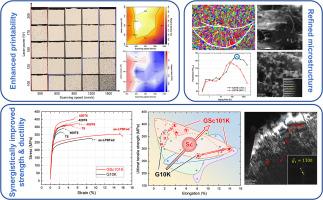Enhanced printability, grain refinement and strength-ductility synergy in a Sc modified Mg-Gd alloy fabricated by laser powder bed fusion
IF 13.8
1区 材料科学
Q1 METALLURGY & METALLURGICAL ENGINEERING
引用次数: 0
Abstract
Additive manufacturing of magnesium alloys provides significant lightweight advantages in aerospace applications. Mg-10Gd-Zr (G10K, wt.%) alloy exhibited promising potential for laser powder bed fusion (LPBF) application, yet it still encounters challenges related to a narrow processing window and relatively low mechanical properties. In this study, Scandium (Sc) was introduced in the pre-alloyed powder to develop the Mg-10Gd-1Sc-Zr (GSc101K, wt.%) alloy tailored for LPBF process. The results indicate that the incorporation of Sc has reduced the laser reflectivity by creating micro grooves on the surface of the GSc101K alloy powder, resulting in a significant expansion of the LPBF processing window. Furthermore, the introduction of Sc in the GSc101K alloy has led to remarkable grain refinement and noticeable weakening of texture due to preferential partitioning of Sc into the α-Mg nucleus to reduce the nucleation energy barrier. The LPBF-GSc101K alloy exhibits a superior elongation (El.) of 14 %, which is primarily attributed to the refined microstructure and activation of non-basal slip systems resulting from the solid solution of Sc. After a deliberately optimized T6 heat treatment, the UTS of the GSc101K alloy reaches 395 MPa while maintaining a reasonable El. of 4 %, achieving a synergistic enhancement in strength and plasticity compared to the G10K alloy. The GSc101K alloy demonstrates exceptional printability, fine and uniform microstructure, and high potential of strengthening through heat treatment, presenting a competitive option for material selection of LPBF-Mg alloys.

激光粉末床熔合法制备Sc改性Mg-Gd合金,增强了其印刷性能、晶粒细化和强度-塑性协同效应
镁合金的增材制造在航空航天应用中具有显著的轻量化优势。Mg-10Gd-Zr (G10K, wt.%)合金在激光粉末床熔合(LPBF)方面具有广阔的应用前景,但仍面临加工窗口窄和力学性能相对较低的挑战。本研究将钪(Sc)引入预合金粉末中,开发出适合LPBF工艺的Mg-10Gd-1Sc-Zr (GSc101K, wt.%)合金。结果表明,Sc的加入通过在GSc101K合金粉末表面形成微槽降低了激光反射率,导致LPBF加工窗口的显著扩大。此外,Sc在GSc101K合金中的引入,由于Sc优先分配到α-Mg核中,降低了形核能垒,导致晶粒细化和织构明显减弱。LPBF-GSc101K合金的延伸率高达14 %,这主要是由于微观组织的细化和Sc固溶导致的非基滑移系统的激活。经过精心优化的T6热处理后,GSc101K合金的UTS达到395 MPa,同时保持了合理的El。4 %,与G10K合金相比,实现了强度和塑性的协同增强。GSc101K合金具有优异的可印刷性、精细均匀的微观组织和热处理强化的高潜力,是LPBF-Mg合金材料选择的一个有竞争力的选择。
本文章由计算机程序翻译,如有差异,请以英文原文为准。
求助全文
约1分钟内获得全文
求助全文
来源期刊

Journal of Magnesium and Alloys
Engineering-Mechanics of Materials
CiteScore
20.20
自引率
14.80%
发文量
52
审稿时长
59 days
期刊介绍:
The Journal of Magnesium and Alloys serves as a global platform for both theoretical and experimental studies in magnesium science and engineering. It welcomes submissions investigating various scientific and engineering factors impacting the metallurgy, processing, microstructure, properties, and applications of magnesium and alloys. The journal covers all aspects of magnesium and alloy research, including raw materials, alloy casting, extrusion and deformation, corrosion and surface treatment, joining and machining, simulation and modeling, microstructure evolution and mechanical properties, new alloy development, magnesium-based composites, bio-materials and energy materials, applications, and recycling.
 求助内容:
求助内容: 应助结果提醒方式:
应助结果提醒方式:


